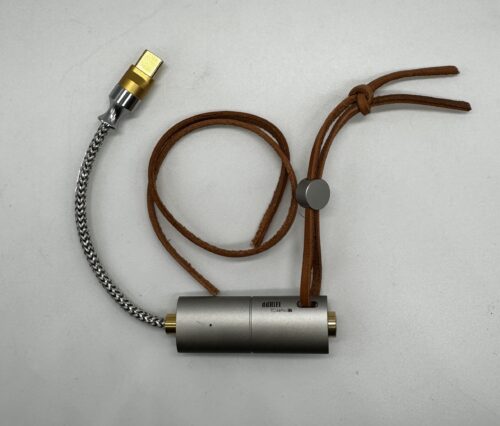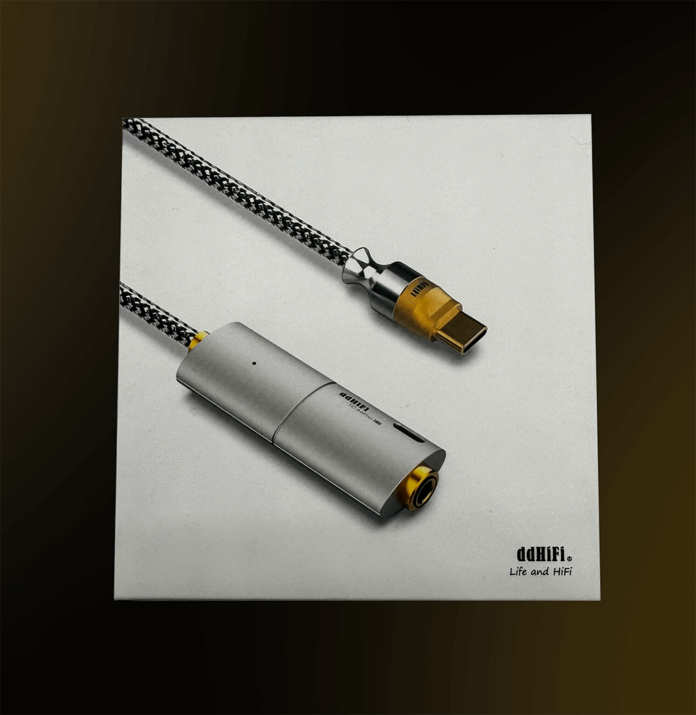The dongle game is fiercely competitive with offerings from many brands on the market. ddHiFi has long staked its claim in the dongle market. In fact, they’re are one of the first brands I think of when it comes to audio dongles and converters. Let’s see if they continue to impress with the TC44Pro E2, which comes in at just around $99.
What You Get
ddHiFi’s TC44Pro E2 comes with limited decadence. In a modest white box with an image of the dongle itself on the cover, you get just a couple things. First, you get the dongle itself, with a leather strap tied onto it. Then you get a second leather strap (untied) and a quick start guide. ddHiFi says the purpose of these leather straps is to help keep the Dongle’s cable length in check. On top of that, there’s a QR code sticker on the side of the box that brings you to a tutorial for tying your very own snake knot. The leather is a nice touch, but overall I found it less useful than I think ddHiFi intended. In my experience, it just made for a bulkier device, which seems counterproductive for a product like this.

Build
The build quality is excellent. The chassis itself is constructed from aluminum and feels very durable. The cable is high quality, made from all pure silver shielded conductors. But my favorite part of the build is the USB-C and 4.4 mm connectors. These are gold plated and feel impenetrable. When plugging into my phone and computer, the USB-C connector fits snugly and securely. There’s practically zero chance of any slippage with this dongle.
Design
ddHiFi intends for the shape of the TC44Pro E2 to look like an eye as they consider all wired dongles to be part of their “Eye” offering. With a tight ovular shape, they succeed. The eye might be a perfect analogy for the whole design ethos of the device. The device uses two Cirrus CS43131 decoding chips and two ESS ES9603Q op amps.
With this design, the ddHiFi TC44Pro E2 is capable of PCM 32 bit/384 kHz decoding and DSD Native DSD64/DSD128/DSD256.

Sound Impressions
The first thing we should get to is power. While this dongle is exclusively balanced, you still won’t want to run famously hard-to-drive headphones off of this. While it offers plenty of power for a sensitive IEM or low impedance headphone, it only actually outputs 250 mW into a 32 ohm load. With that in mind, I tested the TC44Pro E2 with the Moondrop Blessing 3 out of my phone and laptop.
The first thing I noticed is how much dynamics the device brings to the table. Listening to “Diamonds on the Soles of Her Shoes” by Paul Simon, bass drums feel exciting and quick and even in the treble region, snare taps and cymbal crashes are fast and lively. Of course the Blessing 3 are known to have those tendencies as well. This shows that the TC44Pro E2 is fast enough to keep up with, and maybe even outpace, the speed of the Blessing 3.
Overall, I find these to be a very transparent DAC/AMP. The low end is well extended and leaves room for impactful and detailed bass. The midrange is supple but doesn’t color the bright midrange of the Moondrop. Instead, it adds clarity and makes more sense of the information in the vocal range. It does all this while keeping the high end nice and clear. Again, it doesn’t tone down the Blessing 3’s high end. Instead it helps present the detail in as listenable a manner as possible.
Summary
The ddHiFi TC44Pro E2 is a formidable entrant into the crowded dongle world. While you don’t get huge amounts of power or any exciting coloration, you do get great transparency and a dongle perfect for IEM and portable headphone usage. With that and its price in mind, I have no trouble recommending this to someone looking to step up from their included Apple dongle or similar device.
You can find the ddHiFi TC44Pro E2 at Audio46.com.
Compare the ranking of various headphones, earbuds and in-ear monitors using our tools.
Discuss this, and much more, over on our forum.
---MAJORHIFI may receive commissions from retail offers.















